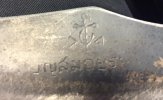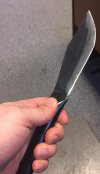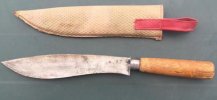So this arrived in the mail today. It was billed as a vintage Indian Gurkha kukri, though I knew that wasn't accurate from the start as the pictures make it look more like a jambiya or a khanjar. I still can't figure out what it is, but it's interesting, if not the highest quality. Might make a good starting point for a similar blade but with better quality. The blade is not sharp at all, and there's gunk on it as you will see from the pictures. It balances an inch out on the blade, and the handle is pretty small for my hands. You can't see it all that well in the photos, but there's also that verdigris stuff on the guard, and the bolster seems to be something plated over brass.
So I'm wondering what the heck this is, and if I'll be doing any kind of damage if I clean it up and sharpen it.







So I'm wondering what the heck this is, and if I'll be doing any kind of damage if I clean it up and sharpen it.














